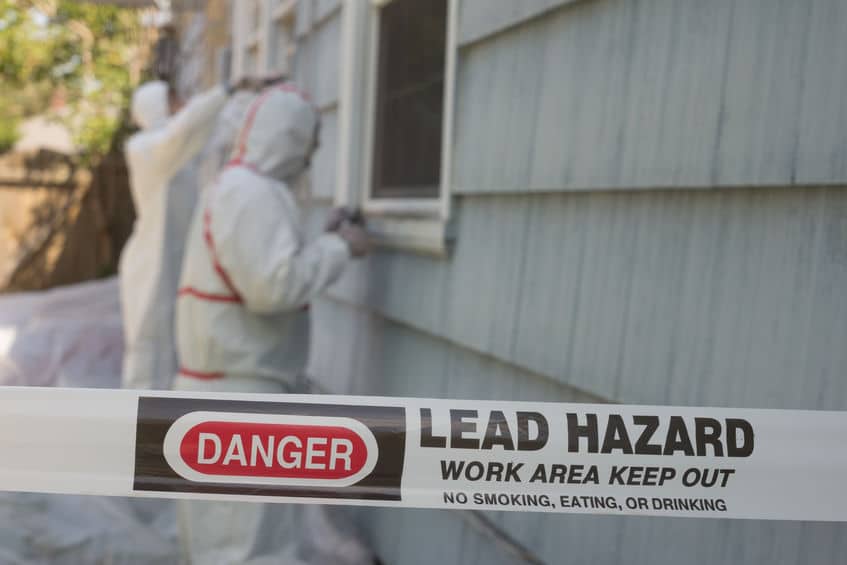Dangers of Lead Paint
Dangers and Health Risks of Lead-Based Paint at Home
Dangers and Health Risks of Lead-Based Paint at Home
While most home builders today do their best to avoid using lead-based paint because of the health risks such paints pose, it hasn’t always been this way. Before the dangers of lead were universally appreciated, lead-based paints were the norm. In fact, if you live in a home built before 1960, it is highly probable that you have lead-based paint on your walls and fixtures.
According to the EPA, 87% of homes constructed before 1940 have lead-based paint. For homes built between 1960 and 1977, 24% have lead-based paints. In 1978, the United States government banned the use of lead-based paints in home settings. Nonetheless, an estimated 24 million homes in the United States contain lead paint and dust.
Lead is a very toxic metal. Lead-based paints generally contain large amounts of the toxic metal and this makes them hazardous to consumers. In the developed world, lead-based paints account for most lead poisoning cases.
These poisoning cases happen mostly when repairs are done at home or when the paint jobs are disturbed in some way. Normal wear-and-tear, especially on frequently disturbed surfaces on stairs, windows, doors, and rails, is also a great driver of lead poisoning at home. Research indicates that even very low levels of lead in the body can lead to significant negative health effects on young children. You, therefore, cannot dismiss small everyday wear-and-tear on surfaces painted using lead-based paints as insignificant.
Exposure to lead at home usually happens when lead-based paint is ingested. Usually, the paint does not present any problem to humans when it is still intact and is not chipping, flaking, or crushed due to everyday wear-and-tear. There is no definite level of exposure to lead that is deemed safe. The range of exposure determines the severity of health effects, especially among young children and pregnant women who are the most at-risk groups. The following are the health effects of lead poisoning:



Lead Poisoning in Newborns, Young Children, and Adults
Lead in the blood can pass from a mother to her unborn baby. When babies are exposed to lead before birth, lead poisoning may manifest in the following ways:
- Preterm low birth weight
- Stunted or slowed growth
- Impaired kidneys, nervous system, and brain
In certain instances, when lead levels in the blood are too high, a pregnant woman may be at risk of miscarriage.
In young children, lead poisoning will manifest in the following ways:
- Learning disability and behavior problems as the child grows
- Loss of appetite and weight loss
- Fatigue and sluggishness
- Pain in the abdomen
- Stunted or slowed growth
- High levels of irritability
- Constipation
- Vomiting
- At high levels, it may even lead to seizures or a coma
In adults, lead poisoning will manifest in the following ways:
- Muscle and joint pain
- Pain in the abdomen
- Mood swings
- High blood pressure
- Difficulty concentrating
- Memory problems
- Low sperm count among males
- Pregnant women may have a miscarriage or stillbirth if lead levels are too high in the blood
Reducing Chances of Lead Poisoning from Lead-Based Paint at Home
If you live in a home that has lead-based paint, you should take the following steps to reduce the chances of lead poisoning:
Wash Children’s Toys: Toys will generally collect paint dust especially if your child uses them or leaves them on the floor. This can facilitate the hand-to-mouth transfer of lead. You should, therefore, consider washing your children’s washable toys regularly to get rid of paint dust.

Maintain the Home Well: Lead-based paint is harmless when it is intact and undisturbed. You should check for signs of peeling and fix any apparent problems as soon as possible. The goal is to eliminate paint dust particles that can be ingested. Therefore, any maintenance work that leads to the generation of paint dust such as sanding is not recommended. Where necessary, hire the services of an experienced maintenance professional.
Let Children Play on Covered Surfaces: In a home where lead-based paint is used, having children play on the soil near the house is not recommended. The ground around the house will definitely have lead-based paint articles that have crushed or peeled off the walls. Therefore, cover the soil with grass or provide something like a sandbox. The sandbox should be covered when it is not in use.
Clean Surfaces Regularly: Surfaces inside the house will collect dust over time – including dust from lead-based paint. To get rid of most of the dust, clean surfaces with a wet cloth or mop.
Wash Children’s Hands after Play: Make sure that your children wash their hands properly after every play session. Basic hand hygiene before handling food is always a good idea to prevent the hand-to-mouth transfer of lead.
Conclusion
Lead poisoning disproportionately affects children and babies. With children and pregnant women being the most at-risk groups, most of your focus should go into ensuring that your children or an expectant mother do not ingest the poison. Even the smallest level of lead in the blood can have tremendous negative long-term effects on the health of your family members. Take all the necessary precautions necessary to prevent lead poisoning resulting from lead-based paint.

